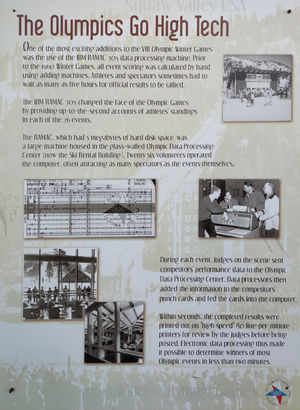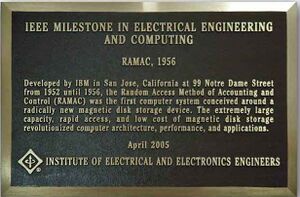Milestones:RAMAC, 1956
- Date Dedicated
- 2005-05-26
- Dedication #
- 60
- Location
- San Jose, CA, U.S.A.
- IEEE Regions
- 6
- IEEE sections
- Santa Clara Valley
- Achievement date range
- 1956
RAMAC, 1956

IEEE Santa Clara Valley Section, Dedication: 26 May 2005
Developed by IBM in San Jose, California at 99 Notre Dame Street from 1952 until 1956, the Random Access Method of Accounting and Control (RAMAC) was the first computer system conceived around a radically new magnetic disk storage device. The extremely large capacity, rapid access, and low cost of magnetic disk storage revolutionized computer architecture, performance, and applications.
Plaque Locations
- Site 1: 99 Notre Dame Ave, San Jose, CA 95113 US (37.335992, -121.896190)
- The IEEE Milestone plaque, historical photographs, and a display board as formerly installed in the interior, along with the ASME plaque that had been installed on its exterior, are all in temporary storage managed by building owner The Swenson Group. The building is officially a San Jose historic landmark, and these items will be reinstalled and made accessible to the public when the building has been leased.
- Site 2: Computer History Museum, 1401 N. Shoreline Blvd, Mountain View, CA 94043 US (37.414757, -122.077679)
Historical significance
On May 6, 1955 International Business Machines Corporation made an announcement that went largely unnoticed outside the computer community and other technical circles. The company reported that a team of engineers working in a small research and development laboratory in San Jose, California, had developed a new magnetic disk storage technology.
Few could have guessed in 1955 that the computer industry's first magnetic disk file, the IBM 350 RAMAC (Random Access Method of Accounting and Control), would one day prove to be of worldwide significance.
What the team of IBM engineers had developed was a technology that significantly affected information processing in the worlds of science, agriculture, health, education, government, finance, insurance, transportation and distribution. This technology ushered in a new era of interactive computer applications such as airline reservation systems, inventory management, automated banking, space flights, word processing and personal computing.
The RAMAC file development could not have had more simple beginnings. It all began with one man, Reynold B. Johnson. In mid-January 1952, Johnson, a former high school science teacher from Ironwood, Michigan, who had been hired to help develop the IBM 805 test scoring machine, received a visit in his office at the IBM Endicott, New York, development laboratory from W. Wallace McDowell, then IBM director of engineering. McDowell had come with an unusual offer.
The company had decided to set up a small research laboratory on the West Coast, and McDowell wanted Johnson to head the project. His job was to find a suitable site, do his own recruiting and establish a laboratory of no more than 50 people.
The new lab was to work on technologies not being pursued in the East. Non-impact printing was one of the areas suggested, another was data reduction. These could make up about 50 percent of the new lab's work The rest was up to Johnson. One of the most remarkable aspects of the 350 RAMAC development effort was the rapidity with which Johnson put his new laboratory into full operation.
In February 1952, he:
1. signed a five-year lease on a building at 99 Notre Dame Avenue in San Jose;
2. began to renovate the building;
3. placed ads recruiting engineers in area newspapers, and
4. started interviewing applicants with the help of Louis D. Stevens, a member of the Defense Calculator Design crew at Poughkeepsie, New York. Stevens, whose assignment was first considered temporary , returned permanently in May 1952 as Johnson's technical assistant.
By July 1952, IBM's new San Jose Research and Development Laboratory was a functioning organization of some 30 people, many hired after only one interview, working on a number of projects, with each engineer usually working on more than one project at a time. Johnson set forth three guiding principles to everyone hired, which added to the vitality of the lab. They were:
1. It is essential that each engineer be familiar with the purpose, function and environment of the machine or machine component on which he is working to the degree that his work affects the proper performance of the function in the ultimate environment
2. It is the responsibility of every engineer to be conversant with all other projects going on in the laboratory.
3. It is the most important assignment of every engineer in this laboratory to give assistance, in the form of consultation, experimentation or suggestions, when asked to by another engineer; and the second most important assignment is that of carrying forward the project to which he is assigned.
Looking back today, it is hard to believe that within three years one of the computer industry’s most important technologies would grow from the efforts of this tiny fledgling operation. Who could have thought so then?
The first 350 C disk file became a commercially available product on September 4, 1956, and was a key component of the IBM 305 RAMAC system, which also included a central processor, card reader and printer. (In its early development. The file itself was called the 305. It became the 350 when the 305 system was announced.)
It is difficult to overstate the impact the 350' s disk technology has had upon the world in the years since its announcement.
Making information directly available for computer processing on demand meant that no longer would processors stand idle while searches were made through reels of magnetic tape or data was punched into cards and sorted for processing. Removing these obstacles helped turn the promise of the computer into reality and set the stage for what has come to be called the Information Age.
The user storage capacity of the RAMAC Disk File was 5 million 6-bit characters. As the RAMAC system did not group bits into 8-bit bytes, this capacity was thus 30 million bits.
References
- The above descriptive text was adapted from the ASME International Historic Landmark brochure, 1984
- IBM Journal of Research and Development paper, 1957: The Random-Access Memory Accounting Machine: The Magnetic-Disk, Random-Access Memory
- A concise RAMAC history is included at pp. 273-314 of the 1986 MIT Press book IBM's Early Computers: A Technical History by Charles J. Bashe, Lyle R. Johnson, John H. Palmer and Emerson W. Pugh.
- Computer History Museum RAMAC Oral History Project
- Blog: IBM 305 RAMAC and the 1960 Winter Olympics
RAMAC Oral History Project
Map




















